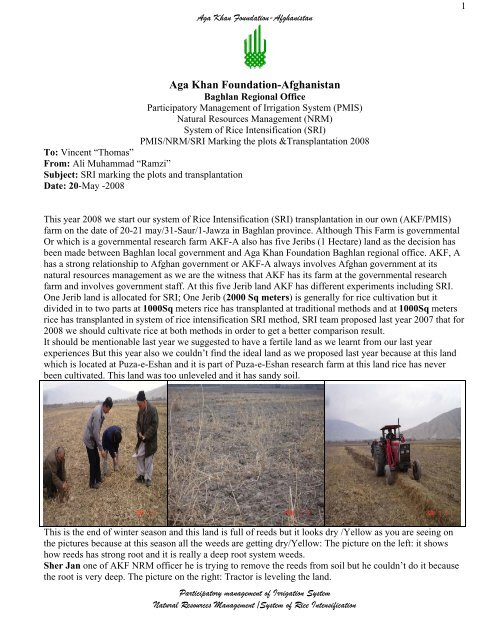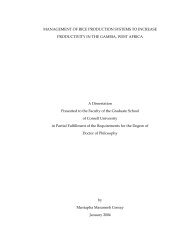Aga Khan Foundation-Afghanistan - The System of Rice Intensification
Aga Khan Foundation-Afghanistan - The System of Rice Intensification
Aga Khan Foundation-Afghanistan - The System of Rice Intensification
Create successful ePaper yourself
Turn your PDF publications into a flip-book with our unique Google optimized e-Paper software.
<strong>Aga</strong> <strong>Khan</strong> <strong>Foundation</strong>-<strong>Afghanistan</strong><br />
<strong>Aga</strong> <strong>Khan</strong> <strong>Foundation</strong>-<strong>Afghanistan</strong><br />
Baghlan Regional Office<br />
Participatory Management <strong>of</strong> Irrigation <strong>System</strong> (PMIS)<br />
Natural Resources Management (NRM)<br />
<strong>System</strong> <strong>of</strong> <strong>Rice</strong> <strong>Intensification</strong> (SRI)<br />
PMIS/NRM/SRI Marking the plots &Transplantation 2008<br />
To: Vincent “Thomas”<br />
From: Ali Muhammad “Ramzi”<br />
Subject: SRI marking the plots and transplantation<br />
Date: 20-May -2008<br />
This year 2008 we start our system <strong>of</strong> <strong>Rice</strong> <strong>Intensification</strong> (SRI) transplantation in our own (AKF/PMIS)<br />
farm on the date <strong>of</strong> 20-21 may/31-Saur/1-Jawza in Baghlan province. Although This Farm is governmental<br />
Or which is a governmental research farm AKF-A also has five Jeribs (1 Hectare) land as the decision has<br />
been made between Baghlan local government and <strong>Aga</strong> <strong>Khan</strong> <strong>Foundation</strong> Baghlan regional <strong>of</strong>fice. AKF, A<br />
has a strong relationship to Afghan government or AKF-A always involves Afghan government at its<br />
natural resources management as we are the witness that AKF has its farm at the governmental research<br />
farm and involves government staff. At this five Jerib land AKF has different experiments including SRI.<br />
One Jerib land is allocated for SRI; One Jerib (2000 Sq meters) is generally for rice cultivation but it<br />
divided in to two parts at 1000Sq meters rice has transplanted at traditional methods and at 1000Sq meters<br />
rice has transplanted in system <strong>of</strong> rice intensification SRI method, SRI team proposed last year 2007 that for<br />
2008 we should cultivate rice at both methods in order to get a better comparison result.<br />
It should be mentionable last year we suggested to have a fertile land as we learnt from our last year<br />
experiences But this year also we couldn’t find the ideal land as we proposed last year because at this land<br />
which is located at Puza-e-Eshan and it is part <strong>of</strong> Puza-e-Eshan research farm at this land rice has never<br />
been cultivated. This land was too unleveled and it has sandy soil.<br />
This is the end <strong>of</strong> winter season and this land is full <strong>of</strong> reeds but it looks dry /Yellow as you are seeing on<br />
the pictures because at this season all the weeds are getting dry/Yellow: <strong>The</strong> picture on the left: it shows<br />
how reeds has strong root and it is really a deep root system weeds.<br />
Sher Jan one <strong>of</strong> AKF NRM <strong>of</strong>ficer he is trying to remove the reeds from soil but he couldn’t do it because<br />
the root is very deep. <strong>The</strong> picture on the right: Tractor is leveling the land.<br />
Participatory management <strong>of</strong> Irrigation <strong>System</strong><br />
Natural Resources Management /<strong>System</strong> <strong>of</strong> <strong>Rice</strong> <strong>Intensification</strong><br />
1
<strong>Aga</strong> <strong>Khan</strong> <strong>Foundation</strong>-<strong>Afghanistan</strong><br />
<strong>The</strong> above pictures show land preparation as the land was unleveled therefore it requires for good leveling<br />
<strong>The</strong> picture on the left: PMIS hired labors to level the land so they are leveling it by shovels and basket.<br />
<strong>The</strong> picture on the right: show this land is full <strong>of</strong> weeds especially Kabal (Kabal is a Dari word) this weed is<br />
a dangerous weed when it cuts in to pieces it multiplies it has long roots and finally it covers the ground<br />
very soon.<br />
And the pictures between left and right labors are collecting the weeds. Look at to the mass <strong>of</strong> weeds!<br />
In next year if AKF will cultivate any crops at this amount <strong>of</strong> 1hectar land it won’t need as much work as<br />
we do this year. So this land is prepared for cultivating any crop in the future but is wasn’t like this before.<br />
<strong>The</strong> above pictures indicates SRI land preparation, the man who is on the left he is building ridges for SRI<br />
and non-SRI plots and the right picture show how the reed is growing fast? Reed is also a deep system root<br />
weeds it is very difficult to destroy this weed from its roots. As reed grows at the swamp it seems here also<br />
was drain in the past and now some part <strong>of</strong> this Baghlan Agriculture research farm has drain too.<br />
Participatory management <strong>of</strong> Irrigation <strong>System</strong><br />
Natural Resources Management /<strong>System</strong> <strong>of</strong> <strong>Rice</strong> <strong>Intensification</strong><br />
2
<strong>Aga</strong> <strong>Khan</strong> <strong>Foundation</strong>-<strong>Afghanistan</strong><br />
As at the method in system <strong>of</strong> rice intensification it is ideal to mark the land or plots before starting<br />
transplantation because at the mentioned method this marking creates 25 cm squares and the space between<br />
each single seedling will be 25 cm and we must transplant the young single seedling which is from 8-days to<br />
13 -days on the each intersection.<br />
<strong>The</strong> picture on the left which is above it is one <strong>of</strong> the Jangharoq SRI volunteer farmers he learned how to do<br />
marking while PMIS/SRI team did the marking and guides the SRI volunteer farmers at the AKF farm then<br />
farmers will go their farm they might do the marking with out presence <strong>of</strong> SRI team but for insuring we<br />
went through to them and carried out the marking at their farms too. <strong>The</strong> picture on the right it shows when<br />
we mark the land it should be wet or must have a slight layer <strong>of</strong> water but it depends to the soil condition.<br />
Look at the picture on the left how AD representatives and SRI volunteer farmers are gathered and watching<br />
the marking process.<br />
<strong>The</strong> above picture on the left it shows that just the plot has evacuated from water and he is doing the<br />
marking. While the marking has been completed we called the participants to come close the SRI nursery<br />
then they came and they are standing around the nursery seedbed. At first we explained what is the age <strong>of</strong><br />
this SRI seedling? What age we should transplant the seedling <strong>of</strong> SRI? What is the best age in system <strong>of</strong> rice<br />
intensification that should be planted as it experimented? It explained how to remove the seedlings from<br />
seedbed at the time <strong>of</strong> removing the roots shouldn’t harm. <strong>The</strong> person who transplants he should remove the<br />
seedlings very carefully by a plate in order to don’t harm the roots.<br />
Participatory management <strong>of</strong> Irrigation <strong>System</strong><br />
Natural Resources Management /<strong>System</strong> <strong>of</strong> <strong>Rice</strong> <strong>Intensification</strong><br />
3
<strong>Aga</strong> <strong>Khan</strong> <strong>Foundation</strong>-<strong>Afghanistan</strong><br />
Finally we start transplantation before transplanting, we briefly explained very precisely to the participants<br />
how to transplant, one single seedling should be transplanted and where to transplant? Of course the single<br />
seedling should be transplanted on intersection because if we lose the intersection and transplant this side<br />
and that side not at the appropriate space which is intersection then our transplanted seedling after 10 days at<br />
the first Weeding it will be destroyed or cut by Mandava weeder <strong>The</strong>refore we must be very careful <strong>of</strong><br />
transplantation to transplant it at the appropriate place which is intersection in order to prevent the<br />
destroying or damaging <strong>of</strong> the plant at the first SRI Weeding.<br />
<strong>The</strong> picture on the left one <strong>of</strong> SRI team member is transplanting SRI at the presence <strong>of</strong> participants whom<br />
they are SRI volunteer farmers and AD representatives we explained to them how to transplant and<br />
participants are watching SRI transplantation with very enthusiasm and it is surprise able for them.<br />
<strong>The</strong>y learned how to transplant then we asked participants who learned and participate at the transplantation<br />
voluntary, the first one who learned among the participants and take part voluntary that is Mr. Muhammad<br />
Rasul <strong>Khan</strong>( the picture between and who has grey hair from right the second person) deputy <strong>of</strong> Baghlan<br />
province Agriculture department head. He is very interested to system <strong>of</strong> rice intensification.<br />
<strong>The</strong> invited people feed backed us and they said as we saw to day system <strong>of</strong> rice intensification is a really<br />
good methods but we will see it at our own farms we hope it will give good results as it gave its results in<br />
other countries. It really safes water which is a vast benefit for down stream area and finally to all farmers<br />
who are along the canal. Seed saving is another benefit we soak 21-28 Kg seed for one Jerib land /2000<br />
Square meters but SRI needs for the same amount <strong>of</strong> land 1 Kg which is a big different and it is very<br />
fantastic. At traditional method we transplant one bunch also the age <strong>of</strong> seedling is 35-40 but at SRI practice<br />
We need to transplant at the space <strong>of</strong> 25 cm one single seedling at the age <strong>of</strong> 8-12 days.<br />
And it produces more than 50 tillers.<br />
<strong>The</strong> picture on the right all SRI volunteer farmers and Agriculture department representatives are taking part<br />
at transplanting as it is too clear on the picture.<br />
<strong>The</strong>n SRI team went through to the farmers’ field and did transplantation jointly.<br />
Participatory management <strong>of</strong> Irrigation <strong>System</strong><br />
Natural Resources Management /<strong>System</strong> <strong>of</strong> <strong>Rice</strong> <strong>Intensification</strong><br />
4

















